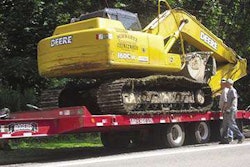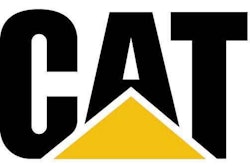
 Brett Hoffman of J.J. Kane
Brett Hoffman of J.J. KaneContractors and heavy equipment fleet managers got an earful of what challenges await them in the construction industry and what the solutions might be at the Randall Reilly Construction Symposium held Wednesday and Thursday in Dallas, Texas.
In a nutshell—the shale oil and gas revolution is going to be great for the construction industry, but an overload of government regulations is threatening to tie everybody up in a regulatory morass.
Truck telematics
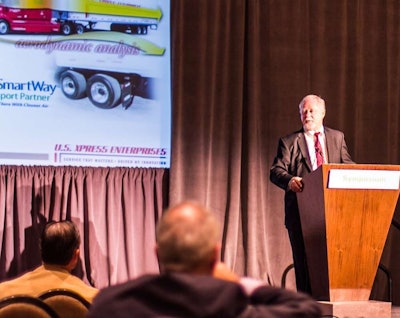 Max Fuller
Max FullerThe symposium kicked off with a presentation from Max Fuller, CEO of the trucking company U.S. Express and a look at how his company’s early adoption of telematics technology propelled him over the competition.
Starting in 1986, Fuller’s trucking company dove headfirst into telematics, which back then was a very new and untested technology. Although he didn’t achieve the promised payback in the first two years, Fuller continued to experiment with how his company used the technology and today his company is thriving.
Fuel prices have gone up 300 percent and truck prices have gone up 400 percent since 1986, Fuller said, and yet his company has still been able to make money despite the fact that freight rates have only risen 38 percent.
“We have been able to change the paradigm of how we worked in the past,” Fuller said. “We were able to take the slop out.”
Fuller admitted it was hard to get dispatchers to accept the new way of doing things at first. The company literally had to take away the phones, yellow legal pads and pens and pencils that dispatchers traditionally relied on and replaced them with computer screens. And drivers at first resented the loss of autonomy and freedom that came from being electronically tethered to home base.
And although a few couldn’t hack the new system and had to be let go, the advantages and popularity of the telematics approach eventually won over everybody. Today, a burdensome set of paperwork requirements placed on drivers by the federal government can be easily managed electronically and Fuller says drivers now prefer to work in a company where telematics can free them from this burden.
The telematics functionality also grew to keep up with the times, adding on-board navigation, road closures and other alerts and information about best available fuel prices. Additionally, U.S. Express puts many of its training videos online, accessible through the in-cab displays in its trucks. Today his company has 200 dispatchers and some 8,000 trucks all tethered to this system.
CSA trucking regulations
Continuing with the theme that what happens to on-road trucking eventually trickles down to the construction trucking market, Jeff Davis, principal, Fleet Safety Services, briefed attendees about federal Compliance, Safety, Accountability regulations. These have already added a huge record keeping burden to the highway trucking industry and are also now being applied to anyone who hauls anything with a GVW greater than 10,000 pounds on a DOT regulated road. This includes landscapers, building delivery trucks and drivers, steel erectors and vocational trucks. You can check out Marcia Gruver Doyle’s full must-read article on Davis’ comments by clicking here.
Equipment appraisals
If you’ve ever worried that you might have left some money on the table in selling or auctioning off your equipment, Brett Hoffman, senior equipment appraiser for J.J. Kane, told Symposium attendees, your suspicions may be well founded.
A credible, accurate appraisal will give you more leverage in auction negotiations, affect your ability to get bonding and financing, add value to your company and may have IRS implications, Hoffman says.
The solution, Hoffman said, was to hire your own independent appraiser. The only alternative to an independent appraisal with a qualified expert on the ground examining your equipment is what Hoffman called a “desktop appraisal.” Lots of banks, finance and insurance companies conduct these types of appraisals which involve no more than looking up the year and model (maybe a serial number) on the internet and assigning an average book value to the equipment.
These desktop appraisals don’t take into account the condition of the equipment, recent rebuilds or upgrades, oil analysis history or anything else that might add value to your equipment, says Hoffman.
Additionally, things like asphalt and concrete plants, crushers and other industrial facilities simply don’t show up in auction and used equipment price guides. The only people who know for certain how much these are worth are industry insiders and inspectors who’ve had years of experience in the field.
In evaluating a potential appraiser, Hoffman advised Symposium attendees to look for someone who is credible, experienced, independent, open to your input, safety conscious and considerate. A good appraiser will work evenings and weekends if necessary to prevent disrupting operations, he said, and come prepared with all his own safety gear.
Hoffman also said contractors and fleet owners should be up front with employees about the reasons for an appraisal. You may be contracting for appraisal to boost your bonding capacity, but when employees see an appraiser on site they will sometimes assume that the company is being prepared for sale and start rumors.
Natural gas fueling
Wednesday wrapped up with a presentation on natural gas fuels for construction trucks from yours truly, executive editor of Equipment World.
The difference between diesel and/or gasoline and natural gas fuel is $1.50 to $2, then it makes sense to invest in light and medium duty trucks with natural gas engines. Upfitting a pickup truck with natural gas engines and fuel tanks can cost $6,000 to $8,000, but the lower cost of natural gas fuels can bring you payback in a year to two years depending on how many miles you drive.
Upfitting a Class 7-8 vocational truck to burn natural gas can run as high as $30,000 to $40,000, but again the payback is easy to calculate. Calculate your fuel price delta, compare it to how much you would spend on diesel and determine your ROI. And once you reach that ROI, the money you save on natural gas fuel drops straight to the bottom line.
In some parts of the country compressed natural gas is running as cheap as $1 per diesel gallon equivalent.
In addition to being a money saver, natural gas is better for the environment, produces 30 to 40 percent less CO2. And natural gas engines burn so clean that they don’t require the expensive exhaust aftertreatment devices that come on every diesel engine above 74 horsepower sold today.
Energy policy, fuel quality and crane rules
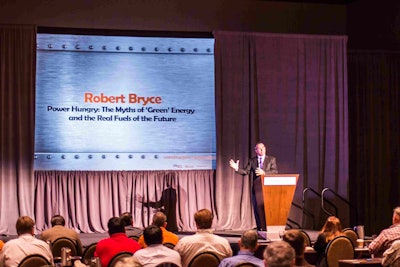 Robert Bryce at the 2013 Construction Symposium.
Robert Bryce at the 2013 Construction Symposium.Thursday morning, the Construction Symposium’s keynote speaker Robert Bryce, author of “Power Hungry: The Myths of Green Energy and the Real Fuels of the Future” gave attendees a rousing defense of traditional fossil fuels and attacked some of the most cherished arguments of those who support green and renewable energy. For more on Bryce’s comments, go to our full article here.
Attendees also heard from Howard Chesneau, president of Fuel Quality Services, who explained that while a certain level of diesel fuel contamination could be tolerated in the past, the new Tier 4 engines were extremely sensitive to contamination issues.
 Howard Chesneau
Howard ChesneauGiven that everyone will eventually be using these Tier 4 engines, Chesneau outlined a complete set of prescriptive steps contractors and fleet managers need to take to insure their fuel storage tanks do not become contaminated. Today’s engines have to filter down to 2 microns, Chesneau said, whereas 10 microns was the norm just a few years ago.
The symposium concluded with a presentation on OSHA’s new rules regarding cranes and especially service truck cranes, from Joel Oliva, manager of program development and administration for the National Commission for the Certification of Crane Operators.
Oliva explained why OSHA felt it had to revamp its crane safety rules and why they decided to regulate cranes, including building material delivery and service truck cranes with lifting capabilities greater than 2,000 pounds.
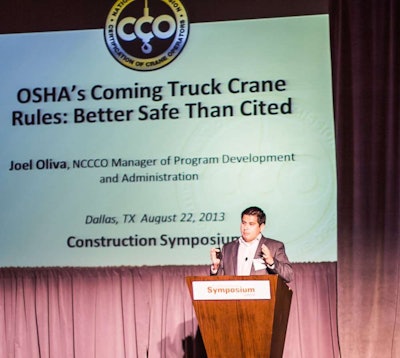 Joel Oliva
Joel OlivaNot many operators of service trucks and small construction contractors are aware that these rules went into effect in 2010, Oliva said.
As of that date, people who fall under the provisions of the new regulations are expected to be “qualified” according to OSHA regulations. This includes not only the driver/operator of the service truck, but any signal person or rigger working with the service truck.





